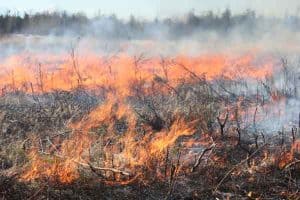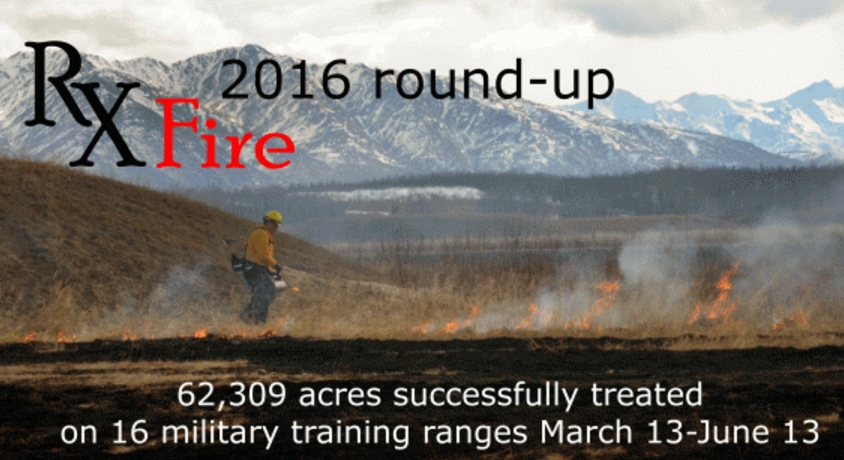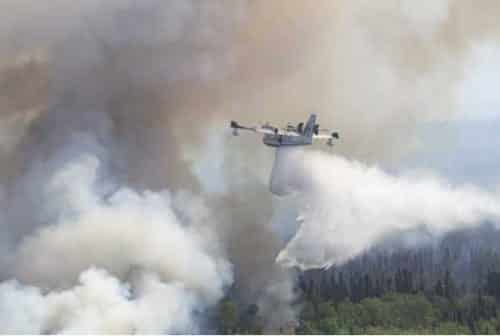
(FAIRBANKS, Alaska) – The Bureau of Land Management Alaska Fire Service (BLM AFS) in cooperation with local, state, federal and military partners implemented several successful prescribed fire projects the past fall and this spring to reduce the risk of wildfires on military training areas. There were 29,379 acres burned between April 15 and May 21 and 1,329 piles burned in the fall on 12 military ranges in Interior Alaska.
For the first time, BLM AFS implemented prescribed fire in the fall by utilizing two compact and mobile ground fuel ignition systems, called a Terra-Torch, to burn debris piles surrounded by snow. Also a first, BLM AFS used an Unmanned Aircraft System this spring to capture aerial footage and images of a prescribed burn to document fire behavior, operational procedures and post-fire monitoring of habitat restoration.
Some of the benefits for using prescribed fire are:
• Reduce the risk of wildland fires that could impact nearby communities including military installations and training facilities helps safeguard our citizens and our firefighters.
• Implements a prescribed fire during favorable conditions is much safer and more effective than attempting to control an unplanned ignition under dry or windy conditions.
• Removes the grass now will reduce fire danger around training targets used during the summer and create barriers that could contain an incidental fire.
• Prescribed burning also promotes the growth of succulent green forage that is resistant to fire, but is favored by small and large species of wildlife and benefits their habitat.
• The prescribed fires increase training opportunities in support of military readiness.
• Burning off the dead grasses while the ground is still frozen and while moisture still remains in the timber is the optimum because these controlled burns won’t spread into the nearby wooded areas. It would be difficult to contain a fire that moves into black spruce during extreme fire conditions.
The U.S. Army Garrison Environmental Department, U.S. Army Alaska, U.S. Air Force, USARAK Range Control, and BLM AFS continue to work together on future mechanical and prescribed fire projects, beginning as early as Aug. 20, 2017, to reduce and mitigate black spruce near active ranges that pose a wildfire threat on lands that draw military from all over the world to train.[xyz-ihs snippet=”adsense-body-ad”]“We’re putting the science, technology and teamwork together to mitigate the risk of wildfires and impact it has on training.” said Mark Adams, USARAK’s deputy chief of operations who leads the multi-agency Fire Mitigation Community of Interest Working Group. Even with the prescribed fire window closed for the summer, the group will continue to hold weekly meetings to discuss training schedules and future wildfire mitigation efforts.
Prescribed fires are conducted when precise weather conditions and site prescriptions are met. The approved prescribed fire plan includes a burn permit approved by the Alaska Department of Environmental Conservation (ADEC). Diligent coordination with the DEC and the National Weather Service is ongoing during the prescribed fire period. BLM AFS works with the ADEC to monitor smoke conditions and air quality during the planning phase and also during the actual burn to ensure it is in compliance with local, state, and federal policies and regulations governing air quality. BLM AFS made every effort to minimize smoke impacts to the surrounding communities, but there may have been noticeable smoke in the project areas for several days after ignition. The duration of each project depends on weather, fuels, and resources available. All prescribed fire projects are compliant with National Environmental Policy Act for the areas that are being treated. [xyz-ihs snippet=”Adsense-responsive”]







